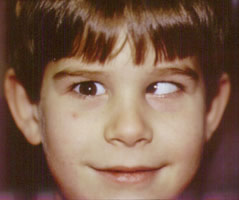
If you think your child may have lazy eye, this article will help you make an informed decision
Lazy eye, also known as amblyopia, is a vision disorder that occurs when one eye has a reduced visual acuity, causing blurred vision in that eye.
Early detection and treatment can aid in the prevention of long term vision problems with the child's eyes. Treatment for amblyopia can include contact lenses or glasses, or patching surgery. There are also other more serious cases where the vision loss is permanent.
Eyes that have amblyopia can be very frustrating and difficult for a parent to watch. It can interfere with a child's ability to focus, make fine motor and verbal skills better, and play well with others. There are treatments available that are helpful in helping children cope with this vision disorder, and with their normal activities.
The term "amblyopic eye syndrome" describes what amblyopia is, but it is not a disease. Lazy eye can occur in just one of the eyes, while the other eye does not have vision problems. It can occur at any time, as a result of several different reasons. There are some genetic variations that increase the risk of amblyopia, and the age of a person can also increase his/her risk. It is not uncommon for one eye to have amblyopia, but to have no symptoms.
One of the most common causes of amblyopia is eye injury or trauma, such as a car accident. However, another common cause is vision loss due to a congenital condition, such as cataracts or macular degeneration. Age, which is a factor in vision loss due to aging, can also be a cause of amblyopia, as can poor circulation of the eye. Some people have a genetic predisposition to amblyopia.
The good news is that there are ways to treat amblyopia that will not only improve vision in the eye, but in the whole face and overall appearance. In some cases, laser surgery may be used. A special type of lens called bifocal contacts can correct amblyopia by changing the shape of the lenses. There are also special glasses that reshape the cornea, improving light transmission. and correcting nearsightedness and farsightedness.

There are also some eye exercises that can strengthen and improve vision in the eye
These exercises target areas of the eye that do not work properly and improve the function of those areas. If a simple eye exercise is performed, vision can be improved for an entire eye.
There are some prescription eye drops that help reduce the risk of amblyopia, and they can also be used for vision care. If the amblyopia is not corrected by glasses or contacts, some vision improvement can be achieved by wearing corrective lenses. For those who want to try an eye patch, patching surgery, or laser surgery, contact lenses may be recommended.
Amblyopia can also be treated with the use of a trifocal, multifocal or bifocal contact lenses. Some people with anorexia may also have this condition, and they should avoid wearing any kind of contact lenses. Lazy eye may also be treated by wearing corrective glasses that adjust the distance between two points in the eye.
There are also special prescription lenses that correct an amblyopic eye. This type of lens has one lens in the lower and one in the upper part of the eye, that adjust to different distances. and refract the image from the middle part of the eye that is below.
For those whose amblyopia is caused by an accident, there are many ways to treat it, but the success varies from case to case. Some doctors prescribe medications, such as prescribed eye drops. For some people, surgery is recommended.
Many natural remedies are also available to treat lazy eye. Some of these remedies include eye exercises and the application of topical drops. In some cases, surgeries are necessary.